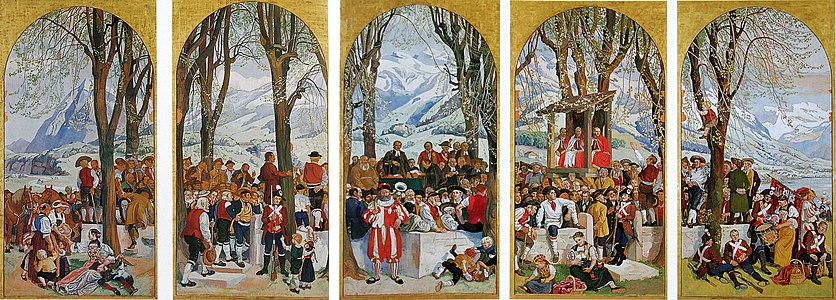Albert Welti

Albert Welti (18 February 1862, Zürich - 7 June 1912, Bern) was a Swiss painter and etcher. Many of his works depicted dreams or nightmares.
Biography[]
He was the oldest of seven children born to Jakob Albert Welti-Furrer (1833-1906), a hauler. Part of the Armée de l'Est was billeted on his grandfather's property in 1871 and watching their activities inspired his later interest in historical scenes.
After completing his primary education, he attended the local Industrieschule, where he studied engraving with Johann Conrad Werdmüller. In 1880, he began a photography apprenticeship with his uncle Oswald Welti (1843-1932) in Lausanne, but stayed with him for only one year. In 1882, he was able to enroll at the Academy of Fine Arts, Munich and came under the influence of Arnold Böcklin, who he met in 1885. After graduating, he obtained financial support from Franz Rose (1854-1912), a generous patron of the arts.
He met and married Emmeline Wildbolz in 1894 and they settled in Höngg, a suburb of Zürich. After his father's death, he assuaged his grief by visiting Innertkirchen and Vättis, where he created numerous pastel nature studies. After that, he worked in Munich until 1908. while there, he became friends with the author, Hermann Hesse.
His wife died, suddenly, in 1911. He died a year later, aged only fifty. His country home in Ostermundigen, near Bern, was bought by Hesse.[1] His work was part of the painting event in the art competition at the 1924 Summer Olympics.[2]
His best known work is probably a fresco, , in the meeting room of the Ständerat at the Federal Palace. It was left unfinished and was completed by Wilhelm Balmer in 1914. In addition to his art, he also designed postage stamps for the Swiss Post.[3][4]
His son, Albert Jakob Welti also became an artist and an author. The popular Swiss singer/songwriter, Sophie Hunger is his grand niece.
Selected works[]

Die Landesgemeinde

Fog Rider
References[]
- ^ Hermann Hesse in: Hartmut Steinicke: Deutsche Dichter des 20. Jahrhunderts, Erich Schmidt Verlag GmbH & Co KG, 1994, S. 177
- ^ "Albert Welti". Olympedia. Retrieved 23 July 2020.
- ^ Tages-Anzeiger "Freimarken 1907–1914. Die Motive, ein Thema im Volk und Parlament", by Reinhard Stutz
- ^ Philatlie Schweiz, Ulrich Fehlmann, "Streit um Walter: Die Polemik um die Briefmarkenausgabe von 1907".
Further reading[]
- Philippe Welti and Gaudenz Welti. Albert Welti, 1862–1912. Schweizer Maler und Zürcher Zünfter. Ein Lebensbild des um 1900 bekanntesten Schweizer Malers und Zeichners. Zunft zur Waag. Zürich 2012. ISBN 978-3-033-03314-6.
External links[]
| Wikimedia Commons has media related to Albert Welti. |
- More works by Welti @ ArtNet
- Literature by and about Albert Welti in the German National Library catalogue
- Albert Welti in German, French and Italian in the online Historical Dictionary of Switzerland.
- 1862 births
- 1912 deaths
- People from Zürich
- Swiss etchers
- 19th-century Swiss painters
- Swiss male painters
- 20th-century Swiss painters
- 20th-century male artists
- Academy of Fine Arts, Munich alumni
- Swiss expatriates in Germany
- 20th-century printmakers
- 19th-century male artists
- Olympic competitors in art competitions


